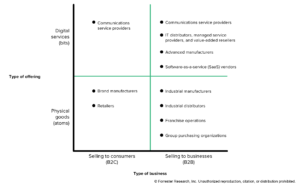Unlock The Marketplace Potential: A Strategic Guide For Tech Leaders
As digital ecosystems evolve, marketplace development platforms are becoming essential tools for scaling commerce, expanding reach, and enhancing partner collaboration. Forrester’s Buyer’s Guide: Marketplace Development Platforms, 2025, offers a strategic framework to help tech executives align their marketplace technology with their internal business models.
Marketplace platforms are not “one size fits all.” Tech leaders must align platform capabilities with their ecosystem strategy to unlock growth, efficiency, and innovation.
Forrester can help with the top three challenges that tech leaders face when navigating marketplace development platforms:
- Complexity in ecosystem-oriented marketplace models. Tech leaders must navigate a wide variety of marketplace types (e.g., B2C atoms, B2B bits, hybrid models) that differ in complexity based on what is sold (physical goods vs. digital services), to whom (consumers vs. businesses), and through whom (direct vs. channel partners). To succeed, your marketplace must enable all participants to thrive. Buyers and sellers must be first-class citizens of the platform. You must understand them both and deliver on their needs continuously. Each model demands different capabilities in pricing, fulfillment, partner management, and customer experience. Forrester can help classify your marketplace needs with our framework and hands-on guidance to identify the right marketplace model for your strategy.
- Governance of your marketplace model with vendor capabilities. Not all marketplace development platforms are equipped to handle the specific needs of a business’s ecosystem. To ensure that all participants thrive, you need to codify your policies and automate governance, scorecarding participants and nudging them toward the behaviors that bring harmony across the platform users. For example, platforms may vary in their support for subscription pricing models, negotiated terms and private offers, third-party seller onboarding and compliance, centralized billing, and flexible fulfillment. Choosing a platform that lacks critical capabilities needed by your strategy can derail you. Forrester can help by shortlisting compatible vendors. Through our Landscape reports and Forrester Wave™ evaluations, Forrester segments vendors based on their strengths in supporting specific marketplace scenarios (e.g., B2B bits, B2C atoms), helping tech leaders find platforms aligned with their needs.
- Balancing differentiation, broad appeal, and operational and technical complexity. Integrating third-party sellers, managing catalog data, and ensuring compliance across a distributed network of partners is operationally intensive. Vendors that specialize in your use cases may have off-the-shelf capabilities you can use rather than building what you think differentiates you. Supporting multitier sales channels (e.g., VARs, MSPs, distributors) and enabling seamless quoting, billing, and provisioning adds further complexity. Forrester can help by evaluating platform capabilities. Forrester highlights critical platform features to assess, such as flexible pricing and billing, private offer and quote negotiation tools, seller onboarding and compliance management, and order and inventory management.
The full Forrester report outlines nine real-world use cases across industries — from SaaS vendors like Salesforce to industrial manufacturers like ABB — each leveraging platforms such as Mirakl, AppDirect, and CloudBlue to meet specific marketplace needs.

If you need help understanding the right marketplace development platform for your business model, let’s talk.
Forrester clients can schedule an inquiry or guidance session with me to talk about your marketplace business model. We can select the right shortlist of vendors and ensure that it aligns with your strategic commitment to the pursuit of continuously improving business results through technology. In the meantime, Forrester clients can read Buyer’s Guide: Marketplace Development Platforms, 2025.
